Manual Shift Mode
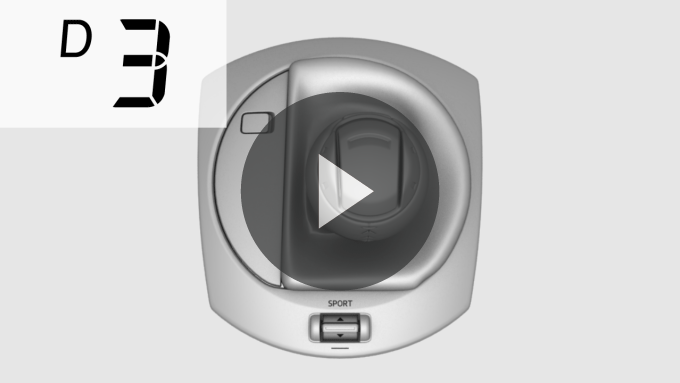
The manual shift mode gives you the feel of driving a manual transmission vehicle by allowing you to operate the selector lever manually. This allows you to control engine rpm and torque to the drive wheels much like a manual transmission when more control is desired.
To change to manual shift mode, shift the lever from D to M.
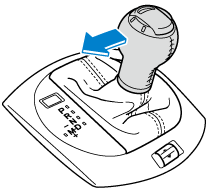
Changing to manual shift mode while driving will not damage the transmission.


To return to automatic shift mode, shift the lever from M to D.
-
If you change to manual shift mode when the vehicle is stopped, the gear will shift to M1.
-
If you change to manual shift mode without depressing the accelerator pedal when driving in D range, 5th gear/6th gear, the gear will shift to M4/M5.


Indicators
Manual shift mode indication
In manual shift mode, the “M” of the shift position indication in the instrument panel illuminates.
Gear position indication
The numeral for the selected gear illuminates.
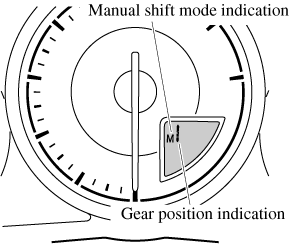
-
If the gears cannot be shifted down when driving at higher speeds, the gear position indication will flash twice to signal that the gears cannot be shifted down (to protect the transmission).


Manually shifting up
You can shift gears up by operating the selector lever or the steering shift switches (Some Models).
M1 → M2 → M3 → M4 → M5 → M6
Using selector lever
To shift up to a higher gear, tap the selector lever back  once.
once.
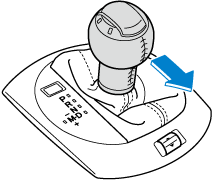
Using steering shift switch (Some Models)
To shift up to a higher gear with the steering shift switches, pull the UP switch ( ) toward you once with your fingers.
) toward you once with your fingers.
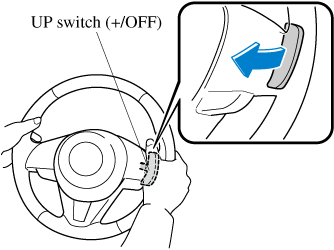
Keep your hands on the steering wheel rim when using fingers on the steering shift switches:
Putting your hands inside the rim of the steering wheel when using the steering shift switches is dangerous. If the driver's air bag were to deploy in a collision, your hands could be impacted causing injury.


-
When driving slowly, the gears may not shift up.
-
Do not drive the vehicle with the tachometer needle in the RED ZONE while in manual shift mode. In addition, manual shift mode switches to automatic shift mode while the accelerator pedal is completely depressed.
This function is canceled while the DSC is turned off. However, if the vehicle is continuously driven at a high rpm, the gears may automatically shift up to protect the engine.
-
The steering shift switch can be used temporarily even if the selector lever is in the D position while driving. In addition, it returns to automatic shift mode when the UP switch (
 ) is pulled rearward for a sufficient amount of time.
) is pulled rearward for a sufficient amount of time.


Manually shifting down
You can shift gears down by operating the selector lever or the steering shift switches (Some Models).
M6 → M5 → M4 → M3 → M2→ M1
Using selector lever
To shift down to a lower gear, tap the selector lever forward  once.
once.

Using steering shift switch (Some Models)
To shift down to a lower gear with the steering shift switches, pull the DOWN switch  toward you once with your fingers.
toward you once with your fingers.
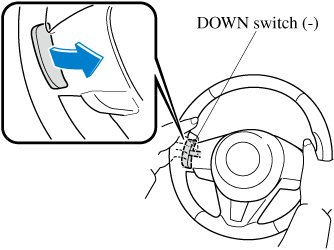
Do not use engine braking on slippery road surfaces or at high speeds:
Shifting down while driving on wet, snowy, or frozen roads, or while driving at high speeds causes sudden engine braking, which is dangerous. The sudden change in tire speed could cause the tires to skid. This could lead to loss of vehicle control and an accident.
Keep your hands on the steering wheel rim when using fingers on the steering shift switches:
Putting your hands inside the rim of the steering wheel when using the steering shift switches is dangerous. If the driver's air bag were to deploy in a collision, your hands could be impacted causing injury.


-
When driving at high speeds, the gear may not shift down.
-
During deceleration, the gear may automatically shift down depending on vehicle speed.
-
When depressing the accelerator fully, the transmission will shift to a lower gear, depending on vehicle speed. However, the gears do not kickdown while the DSC is turned off.


Second gear fixed mode
When the selector lever is moved back  while the vehicle speed is about 10 km/h (6.2 mph) or less, the transmission is set in the second gear fixed mode. The gear is fixed in second while in this mode for easier acceleration from a stop and driving on slippery roads such as snow-covered roads.
while the vehicle speed is about 10 km/h (6.2 mph) or less, the transmission is set in the second gear fixed mode. The gear is fixed in second while in this mode for easier acceleration from a stop and driving on slippery roads such as snow-covered roads.
If the selector lever is moved back  or forward
or forward  while in the second gear fixed mode, the mode will be canceled.
while in the second gear fixed mode, the mode will be canceled.
Shift gear (shifting) speed limit
For each gear position while in the manual mode, the speed limit is set as follows: When the selector lever is operated within the range of the speed limit, the gear is shifted.
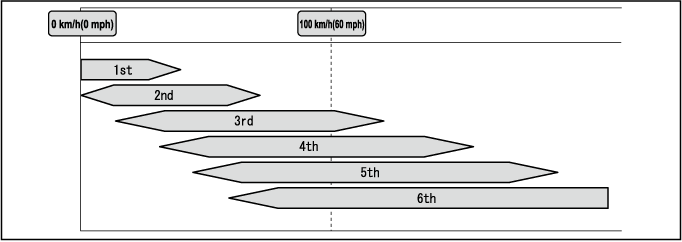
Shift up
The gear does not shift up while the vehicle speed is lower than the speed limit.
Shift down
The gear does not shift down while the vehicle speed exceeds the speed limit.
If the vehicle speed exceeds the speed limit and the gear does not shift down, the gear position indication flashes 2 times to notify the driver that the gear cannot be shifted.
Kickdown
When the accelerator pedal is depressed fully while driving, the gear shifts down.
However, the gears do not kickdown while the DSC is turned off.
The gear also shifts down using kickdown while in the second gear fixed mode.


Auto-shift down
The gear shifts down automatically depending on the vehicle speed during deceleration.
If the vehicle comes to a stop while in the second gear fixed mode, the gear remains in second.


Recommendations for shifting
Upshifting
For normal acceleration and cruising, Mazda recommends these shift points:
|
Gear |
Vehicle speed*1 |
|---|---|
|
M1 to M2 |
24 km/h (15 mph) |
|
M2 to M3 |
40 km/h (25 mph) |
|
M3 to M4 |
65 km/h (40 mph) |
|
M4 to M5 |
73 km/h (45 mph) |
|
M5 to M6 |
81 km/h (50 mph) |
-
Always observe local speed limit regulations.
Downshifting
When you must slow down in heavy traffic or on a steep upgrade, downshift before the engine starts to overwork. This gives better acceleration when you need more speed.
On a steep downgrade, downshifting helps maintain safe speed and prolongs brake life.


 Read this first
Read this first



















